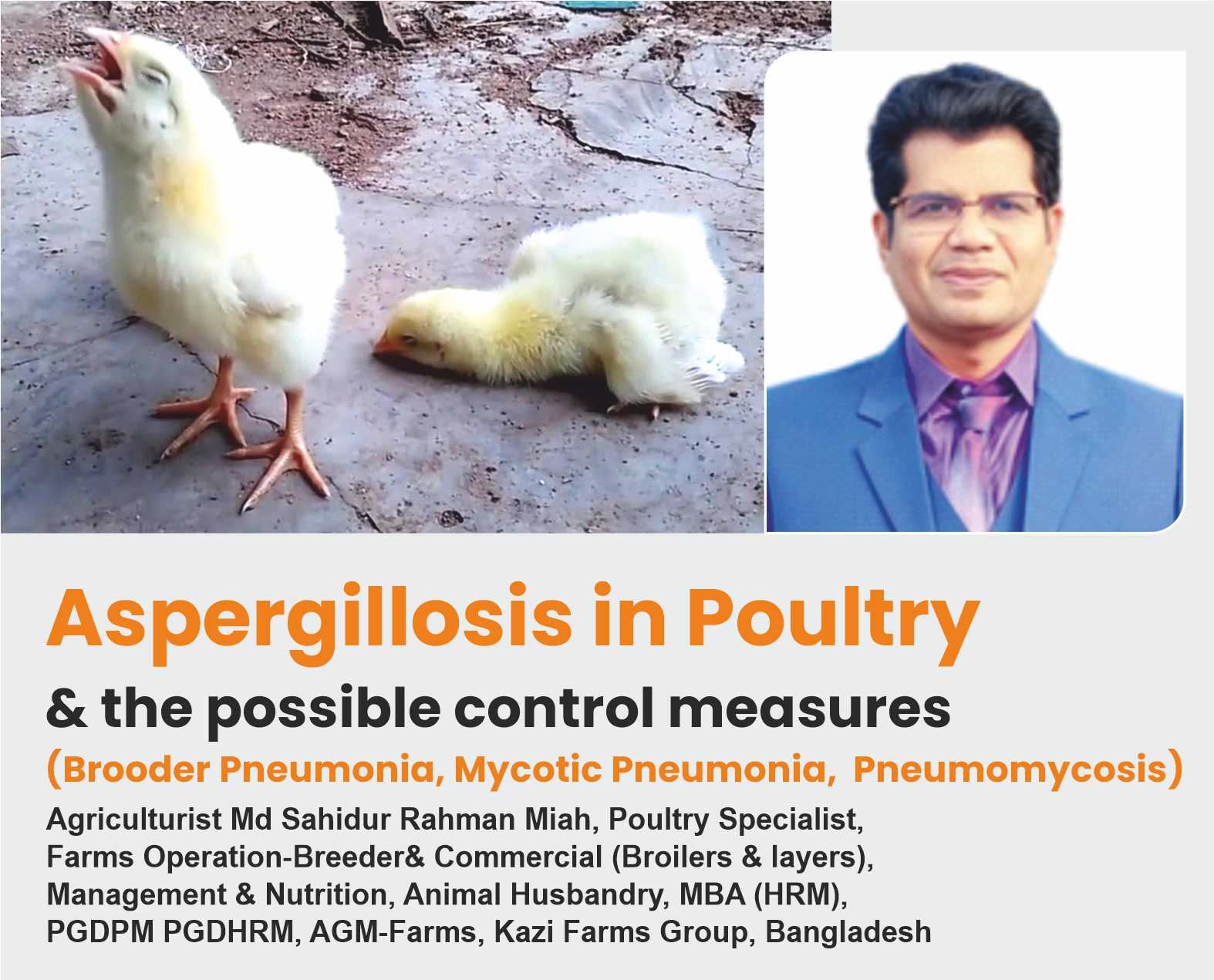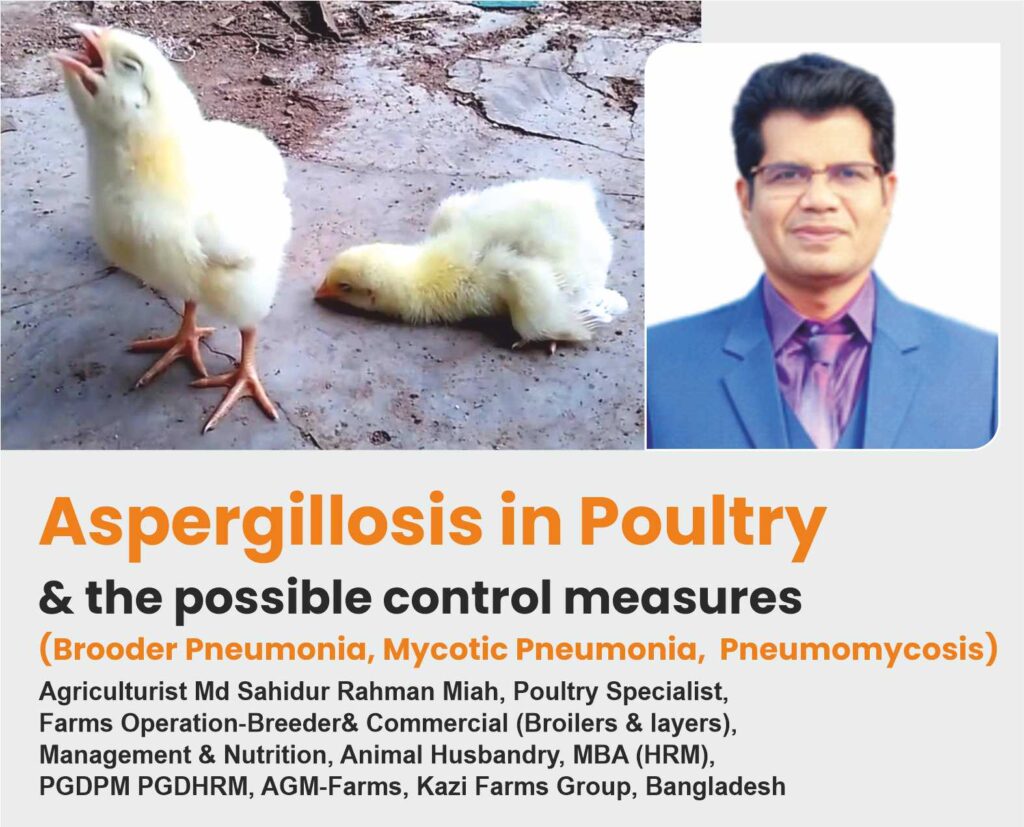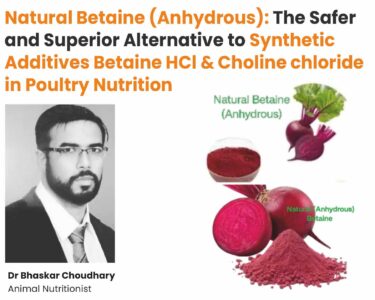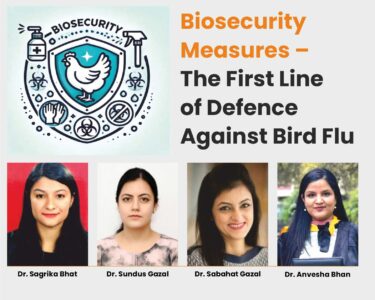Aspergillosis in Poultry & the Possible Control Measures
(Brooder Pneumonia, Mycotic Pneumonia, Pneumomycosis)
Agriculturist Md Sahidur Rahman Miah, Poultry Specialist,
Farms Operation-Breeder& Commercial (Broilers & layers),
Management & Nutrition, Animal Husbandry, MBA (HRM),
PGDPM PGDHRM, AGM-Farms, Kazi Farms Group, Bangladesh
Introduction
Aspergillosis is a fungal infection generally affecting the respiratory system of young poultry. Aspergillus is a sporulated mold with broad nutritional requirements. Aspergillus fumigatus and Aspergillus flavus are the most common species causing aspergillosis in poultry.
Aspergillosis is a fungal infection generally affecting the respiratory system of young birds, invading the trachea, air sacs and lungs. Infection is typically described as acute or chronic. Aspergillus is a sporulated mold with broad nutritional requirements. Aspergillus fumigatus and Aspergillus flavus are the most common species causing aspergillosis in poultry. This is commonly referred to as mycotic pneumonia, brooders pneumonia, or fungal pneumonia.
It is also called fungal pneumonia, but actually affects the bird’s air sacs as well as the lungs. Fungal spores are found naturally in the environment, and are highly resistant to common disinfectants so complete cleaning is required to prevent young birds from being in contact with heavily contaminated bedding. Barn conditions, and especially litter conditions, must be kept optimum with proper heat and ventilation to prevent growth of the mold. Death losses can be up to 50% of birds in a flock if it occurs due to contamination at hatchery.
- Aspergillus is a sporulated mold with broad nutritional requirements. Aspergillus fumigatus and Aspergillus flavus are the most common species causing aspergillosis in poultry.
- Their wide-ranging thermal tolerance makes them ubiquitous organisms on farms and in hatcheries and laboratories.
- Quite resistant to common disinfectants, Aspergillus can grow in solutions of sanitizing fluids and in formalin-fixed tissues.
Clinical signs - In respiratory aspergillosis, birds are seen with dyspnea (difficulty breathing), accelerated respiratory rate, and silent gasping, which is one of the most common findings in poultry (the disease has been called silent pneumonia in the past).
- If the nervous system is affected, birds will show in coordination and poor balance.
- Opacity may develop on the surface of the eyes in cases of ocular infection.
- Necropsy reveals white, creamy nodules in and on the air sacs and viscera.
- The nodules can be found inside the airways, especially near the syrinx, severely occluding air flow and causing the silent gasping condition.
- On rare occasion, the fungal masses can be found in the brain.
Symptoms of Aspergillosis
Symptoms develop in the first 3-5 days after exposure. The most common symptoms are-
1. Rapid, open-mouthed breathing (gasping) due to gradual air passage obstruction & laboured breathing
2. Drowsiness, depression, huddled or isolated behaviour
3. Loss of body condition and general weakness in individual birds
4. Birds may exhibit lethargy,
5. Dehydration & loss of appetite
6. Diarrhea, emaciation, increased thirst, and drowsiness.
7. Eye swelling, blindness, and torticollis (twisting
of the neck to one side) are also typical of Aspergillosis infections.
8. Off feed but may have increased thirst causing wet litter Purchase birds from a good, clean hatchery.
Commonly affected ages?
- Aspergillosis occurs in all poultry. The organisms are present worldwide, but regions with hot and humid seasons are at higher risk of developing a sufficient concentration of mold to cause clinical disease in poultry.
- Mortality spike by 14 days if infected in hatchery or during brooding on moldy bedding. Typically, young birds (first 2 weeks of life) are affected with acute aspergillosis.
- Mature turkeys can also be affected, but in this case the infection is generally chronic.
- It is believed that a high concentration of Aspergillus is required to produce infection; however, high bird density and reduced ventilation may also contribute.
How It Is Spread?
Aspergillosis in birds is not contagious from bird to bird. Birds are typically infected by inhaling spores found in the environment through moldy litter, poor quality feed, and poor bedding management practices. Factors that promote infection of
Aspergillosis include:
– Warm, wet environments
– Poorly ventilated areas
– High humidity environments
– Long-term feed storage
-Impaired immunity
Incubation Period of Aspergillosis
The infection has an incubation period of 2-5 days. Morbidity is usually low, but may be as high as 12%. Mortality among young affected birds is 5-50%.
Pathogenesis
- Under certain conditions, Aspergillus can penetrate the eggshell and contaminate eggs, if the eggs break during incubation, the organism spreads into the hatchery.
- In ovo vaccination may present an increased risk of contamination.
- Heavily contaminated litter can also be the source of the infection. The conidia of Aspergillus are inhaled and deposited deep in the respiratory tract. Hyphae develop on and within the affected cells.
- The massive inflammatory response to the infection is linked to necrosis of the affected tissue. It is thought that Aspergillus disseminates though the blood to many tissues in the body (eyes, brain, air sacs, visceral organs, and bones).
- High mortality and morbidity are expected in affected young animals, whereas the opposite is true in mature birds. Interestingly, aspergillosis is not a transmissible disease (it does not spread from bird to bird).
Diagnosis
- Signs and necropsy findings are generally highly suggestive of the diagnosis, which can be confirmed with culture.
- Growth of only a few colonies should never be considered sufficient evidence for diagnosis because Aspergillus is ubiquitous and can contaminate plates.
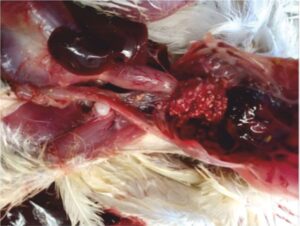
Action Taken if suspect it?
1. Normally there is no treatment and birds do not recover as per satisfactory.
2. Severely affected birds should be culled for humane reasons.
3. Ideally replace all bedding (down to the soil or floor) from the affected poultry house when pneumonia is suspected. At minimum replace visibly moldy or damp bedding (especially from around waterers) because this is most likely to contain mold spores.
The most effective treatment is a newer antifungal drug, voriconazole (Vfend). Amphotericin B is another option. All antifungal drugs can have serious side effects, including kidney and liver damage. Interactions between antifungal drugs and other medications are also common.
Prevention & Control
Clean and disinfect the hatchery on a regular basis. Commercial preparations of enilconazole have been used successfully to disinfect hatcheries and poultry farms. Develop a plan to monitor the presence of Aspergillus in the hatchery. Use clean, mold-free litter and feed.
1. Purchase birds from a good, clean hatchery.
2. Practice Good Sanitation
3. Use clean, dust and mold-free, good quality Bedding (Litter) and Feed.
4. Remove bedding completely between flock
5. Ensure that litter stays dry.
6. Do not let feed accumulate and develop mold in feeders
7. Collect and incubate clean eggs.
8. Fumigate eggs before placing them in the incubator.
9. Clean and disinfect the hatchery on a regular basis.
10. Commercial preparations of enilconazole have been used successfully to disinfect hatcheries and poultry farms.
11. Develop a plan to monitor the presence of Aspergillus in the hatchery.
12. Use clean, mold-free litter and feed.
Treatment
Actually, there is no effective treatment for Aspergillosis in infected birds, so prevention is key to controlling the disease and protecting flocks. Treatment for Aspergillosis is not effective because the drug used does not reach the fungus that is walled off by the bird’s inflammatory response and therefore, isolated from the blood stream. The best treatment results if the granulomatous lesion is dried and topical treatment in conjunction with systematic therapy is given. Treatment of aspergillosis involves the use of one or more systemic antifungal agent. Drugs which are commonly used include itraconazole, ketoconazole, clotrimazole, miconazole, fluconazole and Amphotericin Acute infections typically occur in young chickens. The most effective treatment is a newer antifungal drug, voriconazole (Vfend). Amphotericin B is another option. Besides, Acetic acid (1%, 30 min), Citric acid (50%, 15 min), Peracetic acid (0.2%, 10 min), and Sodium hypochlorite (2.5%, 30 min) showed effectiveness against Aspergillus spp. Mitigation strategies can include:
1) removing the birds from the contaminated environment.
2) removal of contaminated material(s) to limit further exposure.
3) trying not to disturb the contaminated material(s) in order to limit further aerosolization of spores;
4) increased ventilation or air exchange rates to possibly minimize the severity of the outbreak. Strict adherence to cleaning and disinfection procedures for any contaminated environment (eg, hatchery, barn, etc.) will minimize the risk of future outbreaks.
Conclusion and Recommendations
Aspergillosis is a disease of respiratory system of chicken, humans, mammals and wild birds and caused by genus Aspergillus, which is distributed worldwide and it is soil saprophyte. It is a common mismanagement problem and causes a high mortality in chicken.
Environmental factors play an important role in the development of the disease include the number of spores to which the bird exposed, poor sanitation in the house as well as food contaminated with faces promote for fungal growth. Poor ventilation in conjunction with other factor increases the possibility of occurrence of the infection. There is no effective treatment for the disease.
Based on the above conclusion, the following recommendations are forwarded:
- Cleaning and disinfection of feed and water utensils
- Poultry house must be well ventilated.
- Avoid overcrowding in poultry house.
- Avoid moldy or dusty feed.
- Proper Sanitation of hatching equipment.
- Treat poultry house and disinfect the litter with antifungal compound.
- Cull infected birds to prevent further contamination. Use mold inhibitor in the feed for suspected outbreak.


